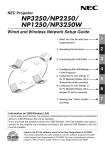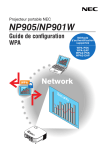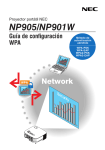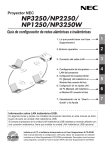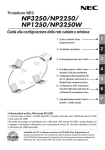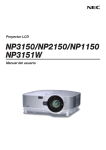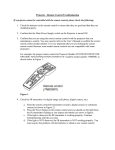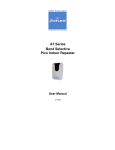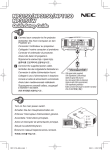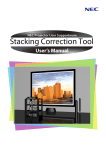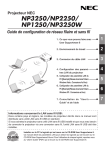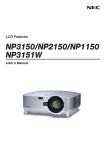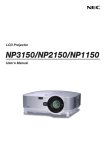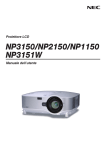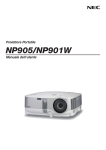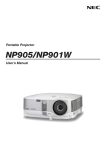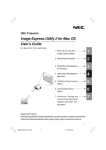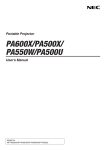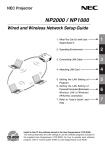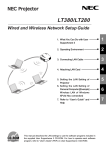Download 5 - NEC Projectors
Transcript
NEC Projector NP3150 / NP2150 / NP1150 NP3151W Wired and Wireless Network Setup Guide LEFT 1 2. Operating Environment 2 3. Connecting LAN Cable 3 4. Setting the LAN Setting of Projector 5. Setting the LAN Setting of Personal Computer ([Example] Wireless LAN of Windows Vista : Ad Hoc connection) 6. Setting the LAN Setting of Personal Computer ([Example] Wireless LAN of Windows XP:Ad Hoc connection) 4 7. Refer to “User’s Guide” and Help 7 LENS 1. What You Can Do with User Supportware 5 SHIFT RIGHT DOWN UP SELECT 3D REFORM AUTO ADJUST SOURCE TAND ON/S BY USB LAMP STATUS POWER WIRELESS WIRELESS Install in the PC the software stored in the User Supportware 5 CD-ROM. This manual describes the LAN settings to use the software programs included in the supplied User Supportware 5 CD-ROM. For how to operate each software program, refer to “User’s Guide” (PDF) on User Supportware 5 CD-ROM. 5 6 Introduction Thank you for purchasing the NEC projector NP3150/NP2150/NP1150/NP3151W (hereafter referred to as the “projector”). The projector is equipped with the following features so that you can give effective presentations. • LAN port (RJ-45), USB Wireless LAN Unit, USB port (type A), supplied as standard • Windows Vista standard functions Network Projector and Remote Desktop can be used. • Viewer that displays images from a USB memory device*1 *1 The projector is not supplied with a USB memory device. The projector is also supplied with User Supportware 5 CD-ROM in which five programs of software are stored for effective use of these features. The software stored on this CD-ROM are as follows. Each program runs on Windows Vista, Windows XP or Windows 2000. Install in the PC the software in the User Supportware 5 CD-ROM before using. • • • • • Image Express Utility 2.0 Desktop Control Utility 1.0 Ulead Photo Explorer 8.0 SE Basic Viewer PPT Converter 3.0 PC Control Utility 3.0 This document explains how to configure the LAN settings to use the above software programs. For details of operations, refer to “User Supportware 5 User’s Guide” on User Supportware 5 CD-ROM and help function of the software. For the network settings on the personal computer, refer to the User’s Manual for the personal computer or the peripheral equipment for the network. Use a wireless LAN card conforming to the Wi-Fi standard for your personal computer. Information on USB Wireless LAN: The NP3150/NP2150/NP1150/NP3151W series projectors distributed in some areas and countries do not come standard with the USB Wireless LAN Unit. If you purchase the projector without the USB Wireless LAN Unit installed and need to present to the projector via a wireless connection, the optional USB Wireless LAN Unit must be installed. NOTES (1) The contents of this guide may not be reprinted in part or whole without permission. (2) The contents of this guide are subject to change without notice. (3) Great care has been taken in the preparation of this guide; however, should you notice any questionable points, errors or omissions, please contact us. (4) Notwithstanding article (3), NEC will not be responsible for any claims on loss of profit or other matters deemed to result from using the Projector. (5) Guides with incorrect collating or missing pages will be replaced. Important Information Important Information USB Wireless LAN Unit FCC Compliance This device complies with Part 15 of the FCC Rules. Operation is subject to the following two conditions:(1) this device may not cause harmful interference and (2) this device must accept any interference received, including interference that may cause undesired operation. This equipment has been tested and found to comply with the limits for a Class B Personal Computer and Peripheral, pursuant to Part 15 of the FCC Rules. These limits are designed to provide reasonable protection against harmful interference in a residential installation. This equipment generates, uses and can radiate radio frequency energy and, if not installed and used in accordance with the instructions, may cause harmful interference to radio communications. However, there is no guarantee that interference will not occur in a particular installation. If this equipment does cause harmful interference to radio or television reception, which can be determined by turning the equipment off and on, the user is encouraged to try to correct the interference by one or more of the following measures: • • • • Reorient or relocate the receiving antenna. Increase the separation between the equipment and receiver. Connect the equipment into an outlet on a circuit different from that to which the receiver is connected. Consult the dealer or an experienced radio/TV technician for help. This equipment has been tested to comply with the limits for a Class B personal computer and peripheral, pursuant to Subpart B of Part 15 of FCC Rules. Only peripherals (computer input/ output devices, terminals, printers, etc.) certified (DoC) or verified to comply with Class B limits may be attached to this equipment. Operation with noncertified (DoC) or non-verified personal computer and/or peripherals is likely to result in Interference to radio and TV reception. The connection of a unshielded equipment interface cable to this equipment will invalidate the FCC Certification of this device and may cause interference levels which Exceed the limits established by FCC for equipment. You are cautioned that changes or modifications not expressly approved by the party responsible for compliance could void your authority to operate the equipment. Regulatory Information/Disclaimers Installation and use of this Wireless LAN device must be in strict accordance with the instructions included in the user documentation provided with the product. Any changes or modifications (including the antennas) made to this device that are not expressly approved by the manufacturer may void the user’s authority to operate the equipment. The manufacturer is not responsible for any radio or television interference caused by unauthorized modification of this device, or the substitution of the connecting cables and equipment other than manufacturer specified. It is the responsibility of the user to correct any interference caused by such unauthorized modification, substitution or attachment. Manufacturer and its authorized resellers or distributors will assume no liability for any damage or violation of government regulations arising from failing to comply with these guidelines. 3 Important Information To comply with FCC RF exposure compliance requirements, the antenna used for this transmitter must be installed to provide a separation distance of at least 7.87"/20cm from all persons and must not be co-located or operating in conjunction with any other antenna or transmitter. SAR compliance has been established in typical laptop computer(s) with USB slot, and product could be used in typical laptop computer with USB slot. Other application like handheld PC or similar device has not been verified and may not compliance with related RF exposure rule and such use shall be prohibited. Usage restrictions in North America The following channels can be used indoors only. • In the United States and Canada: 36, 40, 44, and 48 channels • In Mexico:149, 153, 157, 161, and 165 channels The other channels can be used both indoors and outdoors. This Class B digital apparatus complies with Canadian RSS-210. Cet appareil numerique de la Classe B est conforme a la norme CNR-210 du Canada. To comply with Canada RSS-210 (Issue 7) section A9.4 (b) (ii); this radio product will not transmit on any channels operating in the exclusion band of 5600 - 5650MHz. All channels in the 5600 ~ 5650MHz band will be disabled by factory firmware and is not user changeable. Regulatory Statement: Operation of this device is subjected to the following National regulations and may be prohibited to use if certain restriction should be applied. France: Outdoor use limited to 10mW e.i.r.p. within the band 2454 – 2483.5 MHz. Derogation in French overseas departments of Guyane and La Reunion: outdoor use not allowed in band 2400 - 2420 MHz. Hereby, NEC Display Solutions, Ltd. declares that this USB Wireless LAN Unit (Model: NP01LM) is in compliance with the essential requirements and other relevant provisions of Directive 1999/5/EC. Cautions on security when using wireless LAN products With a wireless LAN, radio waves are used instead of LAN cables for the exchange of data between the wireless access points (computers, etc.), offering the advantage that LAN connections can be made freely within the range of the radio waves. On the other hand, the radio waves reach all points within this range, regardless of walls or other obstacles, possibly resulting in the problems described below if the proper security measures are not taken. • 4 Contents of transmissions may be intercepted Malicious third parties may purposely intercept the radio waves and steal information contained in the transmissions, including such personal information as ID numbers, passwords, credit card numbers, e-mail messages, etc. Important Information • Improper intrusions Malicious third parties may without permission access the personal or company network and steal personal or confidential information, pretend to be someone else and leak incorrect information, rewrite information that has been intercepted, introduce computer viruses or otherwise damage data or the system, etc. Wireless LAN cards and wireless access points generally include security measures for dealing with these problems. Making the proper security settings before using the products can reduce the risk of such problems arising. We recommend that you fully understand the problems that can arise when using the products without making the security settings, then that you make the security settings based on your own decision and at your own discretion. Cautions on Usage • • • • • The USB Wireless LAN Unit is not meant for use with facilities or equipment involving the safeguard of human life, such as medical equipment, nuclear facilities or equipment, aeronautical or space equipment, transportation facilities or equipment, etc., or with facilities or equipment requiring high levels of reliability. Do not use the USB Wireless LAN Unit in such cases. Do not use the USB Wireless LAN Unit near cardiac pacemakers. Do not use the USB Wireless LAN Unit near medical equipment. Doing so may cause electromagnetic interference with the medical equipment, possible leading to death. Do not disassemble or modify the USB Wireless LAN Unit in any way. Doing so could lead to fire or electric shock. Do not use the USB Wireless LAN Unit in wet or moist places, such as in bathrooms or near humidifiers. Doing so could lead to fire, electric shock or malfunction. To prevent damage due to static electricity, eliminate any static electricity from your body before touching the USB Wireless LAN Unit. • Static electricity from the human body may damage the USB Wireless LAN Unit. Before touching the USB Wireless LAN Unit, touch an aluminum sash, a door knob, or some other metal object around you to eliminate the static electricity. The radio waves used by the USB Wireless LAN Unit pass through the wood or glass used in normal homes (but not through window panes with built-in metallic mesh). The radio waves do not pass through iron reinforcing bars, metal or concrete, however, so the USB Wireless LAN Unit cannot be used for communicating through walls or floors made with these materials. 5 Specifications Specifications For United States, Canada, and Mexico Product Name NP01LM3 Operating Voltage 5V (power supplied from the projector) Max Amps Tx: 472 mA (Max) Rx: 300 mA (Max) Wireless Standard IEEE802.11a, IEEE802.11b, IEEE802.11g Modulation Method CCK/DQPSK/DBPSK/OFDM LED Display (Blue) During communication: blinking Standby: slow blinking No operation: light off IEEE802.11a Center Frequency Range/Operating channels 5150 to 5350, 5725 to 5850 MHz 36,40,44,48,52,56,60,64,149,153,157,161,165 channels Transmission method OFDM method (Orthogonal Frequency Division Multiplexing method) Data Rates 54/48/36/24/18/12/9/6 (Mbps) Center Frequency Range/Operating channels 2412 to 2462 MHz 1 to 11 channels Transmission method DS-SS method (direct dispersion spectrum dispersion method) Data Rates 11/5.5/2/1 (Mbps) Center Frequency Range/Operating channels 2412 to 2462 MHz 1 to 11 channels Transmission method OFDM method (Orthogonal Frequency Division Multiplexing method) Data Rates 54/48/36/24/18/12/9/6 (Mbps) IEEE802.11b IEEE802.11g 6 Interface USB 2.0 (connected to USB wireless LAN port on the projector) Dimensions Width:1.1"/28 mm Height:0.43"/11 mm Length:3.03"/77 mm Weight 0.042 lbs/19 g Environmental Considerations Operational Temperatures : 41° to 104°F / 5° to 40°C, 20% to 80% humidity (non-condensing) Storage Temperatures : 14° to 122°F (-10° to 50°C), 20% to 80% humidity (non-condensing) Specifications For other countries except United States, Canada and Mexico Product Name NP01LM2 Operating Voltage 5V (power supplied from the projector) Max Amps Tx: 472 mA (Max) Rx: 300 mA (Max) Wireless Standard IEEE802.11a, IEEE802.11b, IEEE802.11g Modulation Method CCK/DQPSK/DBPSK/OFDM LED Display (Blue) During communication: blinking Standby: slow blinking No operation: light off IEEE802.11a Center Frequency Range/Operating channels 5150 to 5250, 5250 to 5350, 5470 to 5725 MHz 36, 40, 44, 48, 52, 56, 60, 64, 100, 104, 108, 112, 116, 120, 124, 128, 132, 136, 140 channels Transmission method OFDM method (Orthogonal Frequency Division Multiplexing method) Data Rates 54/48/36/24/18/12/9/6 (Mbps) Center Frequency Range/Operating channels 2412 to 2472 MHz 1 to 13 channels Transmission method DS-SS method (direct dispersion spectrum dispersion method) Data Rates 11/5.5/2/1 (Mbps) Center Frequency Range/Operating channels 2412 to 2472 MHz 1 to 13 channels Transmission method OFDM method (Orthogonal Frequency Division Multiplexing method) Data Rates 54/48/36/24/18/12/9/6 (Mbps) IEEE802.11b IEEE802.11g Interface USB 2.0 (connected to USB wireless LAN port on the projector) Dimensions Width:1.1"/28 mm Height:0.43"/11 mm Length:3.03"/77 mm Weight 0.042 lbs/19 g Environmental Considerations Operational Temperatures : 41° to 104°F / 5° to 40°C, 20% to 80% humidity (non-condensing) Storage Temperatures : 14° to 122°F (-10° to 50°C), 20% to 80% humidity (non-condensing) 7 Contents Contents Introduction ................................................................................ Inside cover Important Information ...................................................................................3 Specifications .................................................................................................6 Contents .........................................................................................................8 1. What You Can Do with User Supportware 5 ........................................... 9 1-1. Image Express Utility 2.0 ...................................................................................... 9 1-2. Desktop Control Utility 1.0 .................................................................................. 11 1-3. Ulead Photo Explorer 8.0 SE Basic .................................................................... 12 1-4. Viewer PPT Converter 3.0 .................................................................................. 13 1-5. PC Control Utility 3.0 .......................................................................................... 13 2. Operating Environment ..........................................................................14 2-1. Supported Projector ............................................................................................ 14 2-2. Supported the wireless LAN security type ......................................................... 14 2-3. Operating Environment ....................................................................................... 15 3. Connecting LAN Cable ...........................................................................16 4. Setting the LAN Setting of Projector ....................................................17 4-1. Displaying On-Screen Menu (NETWORK SETTINGS) ..................................... 17 4-2. Wireless LAN ...................................................................................................... 19 4-3. Wired LAN ........................................................................................................... 28 5. Setting the LAN Setting of Personal Computer ([Example] Wireless LAN of Windows Vista: Ad Hoc connection) ....30 6. Setting the LAN Setting of Personal Computer ([Example] Wireless LAN of Windows XP: Ad Hoc connection) ........34 7. Refer to “User’s Guide” and Help .........................................................39 7-1. Displaying “User’s Guide” (PDF) ........................................................................ 39 7-2. Using Help ........................................................................................................... 41 8 1. What You Can Do with User Supportware 5 1. What You Can Do with User Supportware 5 1-1. Image Express Utility 2.0 Image Express Utility 2.0 is a software tool used to send the screen of your personal computer to the projector via a network, without the signal cables. ● High-speed, high-quality image transmissions based on NEC’s original compression algorithm LEFT LEFT SHIFT SHIFT RIGHTRIGHT LENS LENS DOWNDOWN UP UP SELECT 3D REFORM AUTO ADJUST SOURCE ND ON/STA BY USB LAMP STATUS POWER WIRELESS WIRELESS ● Simultaneous projection by multiple projectors Images can be sent from a personal computer to not only one projector but also to two or more projectors at the same time. LEFT LENS SHIFT RIGHT DOWN UP SELECT 3D REFORM AUTO ADJUST SOURCE ON/STAN D BY USB LAMP STATUS POWER WIRELESS WIRELESS LEFT LENS SHIFT RIGHT DOWN UP SELECT 3D REFORM AUTO ADJUST SOURCE ON/STAN D BY USB LAMP STATUS POWER WIRELESS WIRELESS ● “Easy Connection” function for connecting wireless LAN By using “Easy Connection” function*1, the complicated setting of wireless LAN can be simplified. *1 This function can be used when Windows XP is used as the OS and when you have a “Computer Administrator” privilege. If the OS is Windows Vista, input of logon password as “Administrator” may be prompted. The “Easy Connection” function cannot be used with Windows 2000. 9 1 What You Can Do with User Supportware 5 NEC’s original compression algorithm allows high-quality images to be sent over the network at high speed, from your personal computer to the projector. 1. What You Can Do with User Supportware 5 ● Projected images can be transferred and saved to personal computers. When “Meeting Mode” is used, projected images can be sent to the personal computers of all the participants (attendants) of a “Meeting”. The received images can be saved to your personal computer with a memo (text data) attached. Attendant LEFT LENS SHIFT RIGHT DOWN UP SELECT 3D REFORM AUTO ADJUST SOURCE ON/STAND BY USB LAMP STATUS POWER WIRELESS WIRELESS Attendant Presenter Attendant ● 1-click switching of presenter When switching to another presenter during the conference, the participants (attendants) can simply click a button to switch over to the new presenter. ● Central management of the projecting personal computer Using the Training Mode allows you to use a single personal computer (Manager) to manage which personal computer (Attendant) projects. Possible operation includes switching projecting personal computers to project from, as well as temporarily terminating communication with the projector. Mr. D, please start your presentation. Manager LEFT LENS SHIFT RIGHT DOWN UP SELECT 3D REFORM AUTO ADJUST SOURCE ON/STAND BY USB LAMP STATUS POWER WIRELESS WIRELESS Attendant A Attendant B Attendant D (presenter) Attendant C Note The Training Mode is not installed via the “Typical” installation option when Image Express Utility 2.0 is installed. To use Training Mode, select “Extension” installation option on the install selection screen that is displayed while Image Express Utility 2.0 installation is in progress, and select “Training (Attendant)” or “Training (Manager)”. 10 1. What You Can Do with User Supportware 5 1-2. Desktop Control Utility 1.0 Desktop Control Utility 1.0 is software that operates the desktop screen of a personal computer at a remote location from the projector by using a network. ● A commercially available USB mouse is connected to the projector to operate the personal computer. Conference room LEFT LENS SHIFT RIGHT DOWN UP SELECT 3D REFORM AUTO ADJUST SOURCE ON/STAND BY USB LAMP STATUS POWER WIRELESS WIRELESS Office Important • You can use the Desktop Control Utility 1.0 to operate a personal computer located in a separate room from the projector over a network. Therefore, care must be exercised to prevent any third party from viewing the screen of your personal computer (important documents), copying files, or turning off the power. NEC assumes no liability for any loss or damages arising from information leak or system failure while you are using Desktop Control Utility 1.0. • In the Windows operating system, select [Control Panel] → [Hardware and Sound] → [Power Options]. Set [Change when the computer sleeps] to [Never]. (in the case of Windows Vista) This will disconnect LAN connection when the personal computer goes in the standby mode while the Desktop Control Utility 1.0 is being used. • The screen saver function is off while Desktop Control Utility 1.0 is running. 11 1 What You Can Do with User Supportware 5 ● Suppose, for example, a PowerPoint file to be presented in a conference is saved to a personal computer in your office. If this personal computer is connected to the projector in the conference room with LAN when the conference is held, the desktop screen of the personal computer in your office (Windows Vista/Windows XP/Windows 2000) can be projected and the PowerPoint file can be presented by operating the projector. In other words the personal computer does not need to be brought into the conference room. 1. What You Can Do with User Supportware 5 1-3. Ulead Photo Explorer 8.0 SE Basic Ulead Photo Explorer 8.0 SE Basic (hereafter referred to as “Ulead Photo Explorer 8.0”) is a multimedia image file management tool developed by Ulead Systems, Inc. This tool has functions to capture images from a digital camera or scanner and to process or edit images, as well as image file management functions. In addition, slideshows and screen savers can also be easily created. ● Ulead Photo Explorer 8.0 in the User Supportware 5 CD-ROM has functions that allow you to use the projector more conveniently, in addition to the functions that come with the software, for when an NEC projector is connected. Additional functions are listed below. For details of each function, refer to the help function of Ulead Photo Explorer 8.0. • Send Image Sends images to the projector. • Converting PowerPoint file Converts a PowerPoint file into an image file. • Send Logo Registers an image file as the logo data of the projector. • Capture Saves the screens of the personal computer as image files. • Start Slide Show Sends the image of a slideshow to the projector and executes the slideshow on the projector. • Viewer Output Converts a slideshow into an index file that can be played back by the viewer function of the projector and outputs the index file. • Connection Selection Select the projector to connect. ● The personal computer and projector may be connected with wired LAN or wireless LAN. 12 1. What You Can Do with User Supportware 5 1-4. Viewer PPT Converter 3.0 Viewer PPT Converter 3.0 is software that converts files created with PowerPoint 95/97/ 2000/ 2002/2003/2007 into an index file that can be displayed with the viewer function of the projector. ● When converting, specify a USB memory device as the destination to which the index file is to be saved. Then you can easily make your presentation by simply inserting the USB memory device into the projector (viewer function of the projector). 1-5. PC Control Utility 3.0 PC Control Utility 3.0 is software that allows you to operate the projector from the personal computer when the personal computer and the projector are connected with LAN (wired or wireless) or a serial cable. ● You can operate the projector as follows from your personal computer. For details of each function, refer to the help function of PC Control Utility 3.0. • • • • • Power on/off Input signal switching Muting (temporarily disabling audio/video) Freezing (locking the projected image) Logo image transmission 13 1 What You Can Do with User Supportware 5 ● If PowerPoint 2000/2002/2003/2007 is installed in your personal computer, you can activate Viewer PPT Converter 3.0 from PowerPoint (PPT Converter add-in is automatically registered to PowerPoint). 2. Operating Environment 2. Operating Environment 2-1. Supported Projector User Supportware 5 supports the following NEC projector (as of March 2008) NP Series NP3150/NP2150/NP1150/NP3151W/NP905/ NP901W VT Series VT800* * The “Easy Connection” function cannot be used with VT800. Reference Some of software can be used with projectors other than the above projectors. For details, refer to the help function of each software. 2-2. Supported the wireless LAN security type The projector supports the wireless LAN security called WPA-PSK or WPA2-PSK (encryption type:TKIP/AES) as well as WEP. WPA-PSK or WPA2-PSK (TKIP/AES) provides stronger security than WEP where encryption keys are automatically changed, also providing simple authentication. ● The projector’s WPA-PSK/WPA2-PSK supports the TKIP or AES encryption type. ● WPA-PSK/WPA2-PSK is available only when “INFRASTRUCTURE” is selected in “NETWORK TYPE” of the “CONNECTION” page. 14 2. Operating Environment 2-3. Operating Environment The following is the operating environment for Image Express Utility 2.0. For the operating environment of other software, please refer to the help function of each software. Supported OS Supported hardware IBM PC/AT compatible personal computers CD-ROM drive required for installation CPU • Windows Vista Pentium 4/Pentium M of 800 MHz or higher required Dual core CPU of at least 1 GHz is recommended • Windows XP/2000 Sender personal computer Pentium MMX processor or higher required Pentium 800 MHz or higher recommended Recipient personal computer Pentium III 800 MHz or higher required Pentium 4 1.6 GHz or higher recommended Memory • Windows Vista 512 MB or more required (1 GB or more recommended). • Windows XP 128 MB or more required (192 MB or more recommended) • Windows 2000 64 MB or more required (128 MB or more recommended) More memory may be necessary if other applications run at the same time. Graphic processor (Windows Vista) The “Graphics” score of “Windows Experience Index” recommends 3.0 or more. Network environment TCP/IP-compatible wired LAN or wireless LAN environment required Resolution 1024 dots x 768 lines recommended 1024 dots x 768 lines - 1280 dots x 800 lines recommended (NP3151W/NP901W) Screen Colors High Color (15 bits, 16 bits) True Color (24 bits, 32 bits) • 256 or fewer colors are not supported. 15 2 Operating Environment Windows Vista (32-bit version) Home Basic Windows Vista (32-bit version) Home Premium Windows Vista (32-bit version) Business Windows Vista (32-bit version) Ultimate Windows Vista (32-bit version) Enterprise Windows XP Home Edition Service Pack 2 or later Windows XP Professional Service Pack 2 or later Windows XP Tablet PC Edition (Windows XP Tablet PC Edition Service Pack 2 or later) Windows 2000 Professional Service Pack 4 or later • Windows power-saving function is not supported. • The “Easy Connection” supports the “Administrator” privilege of Windows Vista or the “Computer Administrator” privilege of Windows XP. 3. Connecting LAN Cable 3. Connecting LAN Cable Connect a LAN cable to the LAN port (RJ-45) of the projector when connecting the projector to wired LAN. After connecting LAN cable to the projector, set the required settings for the projector ( next page). Server HUB, etc. LAN cable (commercially available) LAN USB(LAN) WIRELESS WIRELESS 16 4. Setting the LAN Setting of Projector 4. Setting the LAN Setting of Projector Reference For how to turn on/off the power to the projector and how to operate the buttons and remote control of the projector, refer to “User’s Manual” included in the User’s Manual CD-ROM. 4-1. Displaying On-Screen Menu (NETWORK SETTINGS) Preparation: Turn on the power to the projector and project images to the screen. It is not necessary to select the signals. 1 Press the button. The on-screen menu will be displayed. 4 3 Press the Setting the LAN Setting of Projector 2 Use the button to select the Setup submenu. button. The “BASIC” tab will be highlighted. 17 4. Setting the LAN Setting of Projector 4 Press the button to highlight the “INSTALLATION” tab. 5 Press the SELECT button to highlight “NETWORK SETTINGS”, and press the button. The “NETWORK SETTINGS” screen will be displayed. • To make setting of wireless LAN next page). Proceed to “4-2. Wireless LAN” ( • To make setting of wired LAN Proceed to “4-3. Wired LAN” ( page 28). 18 4. Setting the LAN Setting of Projector 4-2. Wireless LAN When connecting the wireless LAN, configure the LAN settings in the “WIRELESS” page of “NETWORK SETTINGS” selected from On-Screen Menu. ■ Flow of Setting Step 1 Display "WIRELESS" page of "NETWORK SETTINGS". Step 2 Select "PROFILES". Step 3 Enable or disable "DHCP". If "Disabled" (without check mark) If "Enabled" (with check mark) Step 4 Input "IP ADDRESS". If "EASY CONNECTION" is selected Step 5 Input "SUBNET MASK". 4 Step 6 Input "GATEWAY". Setting the LAN Setting of Projector Step 7 Input "DNS CONFIGURATION". Step 8 - 16 Setting of "ADVANCED". 8 Setting of "CONNECTION". 13 Setting of "SECURITY" 9 Select SSID in "SITE SURVEY". 14 Select "SECURITY TYPE". 10 Input "SSID" (if necessary). 15 Select "KEY SELECT". 11 Select "NETWORK TYPE" (if necessary). 16 Set "KEY 1 to KEY 4". 12 Select "CHANNEL" (if necessary). Step 17 Finalize "ADVANCED". Step 18 Reconnect the network. Step 19 Finalize the setting. 19 4. Setting the LAN Setting of Projector ■ Setting Wireless LAN 1 Display the “WIRELESS” page of “NETWORK SETTINGS”. Configure the setting of wireless LAN in the “WIRELESS” page of “NETWORK SETTINGS” selected from On-Screen Menu. <1> In the “NETWORK SETTINGS” setting window, if the “GENERAL” tab is highlighted, press the button to highlight “WIRELESS”. The “WIRELESS” page will be displayed. • If “NETWORK SETTINGS” is not displayed, refer to “4-1. Displaying On-Screen Menu (NETWORK SETTINGS)” ( page 17). 2 Select “PROFILES”. <1> Press the SELECT button once to highlight the “PROFILES” field and press the button. <2> Use the SELECT / button to highlight “PROFILE 1”, and press the button. • “PROFILE 1” or “PROFILE 2” can be stored in the memory of the projector as the setting for LAN. • “EASY CONNECTION” is a mode in which the personal computer that runs Image Express Utility 2.0 in the User Supportware 5 CD-ROM is easily connected to wireless LAN. Note that “EASY CONNECTION” does not support software other than Image Express Utility 2.0. • When “EASY CONNECTION” is selected, the IP ADDRESS and SUBNET MASK do not have to be set. To use “EASY CONNECTION”, the user account of Windows must be [Administrator] privilege (Windows Vista) or [Computer Administrator] privilege (Windows XP). It cannot be used with Windows 2000. 20 4. Setting the LAN Setting of Projector 3 Set “DHCP”. Check this check box if the network to which the projector is to be connected automatically assigns the IP address via the DHCP server. <1> Press the SELECT button once to highlight the “DHCP” check box and press the button. A check will be given if there is no mark found in the box. • To clear the check box, press the button once again. • If “DHCP” is checked, move the highlight to “ADVANCED” and press the button. Proceed to step 9 ( page 23). Input “DNS CONFIGURATION” field as necessary. • If “DHCP” is not checked, input “IP ADDRESS”, “SUBNET MASK”, “GATEWAY”, and “DNS CONFIGURATION” as necessary. After each item has been set, move the highlight to “ADVANCED” and press the button. Proceed to step 9 ( page 23). 4 Input “IP ADDRESS”. If “DHCP” is not checked, input the IP address assigned to the projector by the administrator of the network to which the projector is connected. <1> Press the SELECT button once to highlight the “IP ADDRESS” field and press the button. The software keyboard will be displayed. button. <3> Repeat step <2> above to input the IP address. • Each button on the software keyboard has the following function. • “SP” .................. Inputs space. • “BS” .................. Deletes one character to the left of the character insertion position in the “IP ADDRESS” field. • “ <<” “ >>” .......... Moves the character insertion position in the “IP ADDRESS” field to the left or the right. • [OK] .................. Finalizes the input character and closes the software keyboard. • [CANCEL] ........ Cancels the input character and closes the software keyboard. 21 Setting the LAN Setting of Projector <2> Use the SELECT button to select a number to input, and press the The characters will be input. 4 4. Setting the LAN Setting of Projector 5 Input “SUBNET MASK”. If “DHCP” is not checked, input the subnet mask of the network to which the projector is connected. The method of inputting is the same as that of the “IP ADDRESS” field. 6 Input “GATEWAY”. If “DHCP” is not checked, input the default gateway of the network to which the projector is connected. The method of inputting is the same as that of the “IP ADDRESS” field. 7 Input “DNS CONFIGURATION”. Set the IP address of the DNS server of the network to which the projector is connected. The method of inputting is the same as that of the “IP ADDRESS” field. Example of setting 1 8 Select “ADVANCED”. Set “CONNECTION” and “SECURITY” (encryption) specific to wireless LAN. <1> Use the SELECT / button to highlight “ADVANCED” on the “WIRELESS” page and press the button. The “ADVANCED” screen will be displayed. 22 4. Setting the LAN Setting of Projector 9 Select SSID from “SITE SURVEY” (if necessary). A list of SSID that can be connected to wireless LAN in this place are displayed, and the SSID that are to be connected are selected from this list. When SSID is selected from the list, the “SSID” field, “TYPE” field and “CHANNEL” field will also be automatically set. <1> Press the SELECT button once to highlight “SITE SURVEY” and press the Searching SSID will begin. When searching SSID is complete, a list of SSID is displayed. button. Icon ............ Wireless access point ............ Personal computer (AD HOC) 4 ........... WEP or WPA-PSK setting Note To connect SSID for which WEP or WPA-PSK is set, the same setting must be made on the projector ( page 25). 10 Input or edit “SSID” (if necessary). SSID selected in “SITE SURVEY” are automatically input. If the highlight is moved to the “SSID” field and the button is pressed, a software keyboard is displayed and characters can be input or edited. The default setting of the projectors is “NECPJ”. 23 Setting the LAN Setting of Projector <2> Use the SELECT / button to highlight the SSID of the network to be connected. Press the button once to highlight [OK] and press the button. If the SSID to be connected is not on the list, press the EXIT button. 4. Setting the LAN Setting of Projector 11 Select “NETWORK TYPE” (if necessary). The communication mode of the SSID selected in “SITE SURVEY” are automatically selected. The settings can be changed by moving the highlight to the “NETWORK TYPE” field and pressing the button. • “INFRASTRUCTURE” .. This is selected if communication is performed with two or more devices connected by wired or wireless LAN via a wireless access point. • “AD HOC” ..................... This is selected when using the wireless LAN to directly communicate without a wireless access point. Example of connection when “NETWORK TYPE” is “INFRASTRUCTURE” Example of connection when “NETWORK TYPE” is “AD HOC” LEFT LENS SHIFT RIGHT LEFT LENS SHIFT RIGHT DOWN UP DOWN SELECT UP SELECT 3D REFORM AUTO ADJUST SOURCE 3D REFORM ND ON/STA AUTO BY USB LAMP STATUS POWER ADJUST SOURCE ON/STA ND WIRELESS BY USB LAMP STATUS POWER WIRELESS WIRELESS WIRELESS Wireless Access point Wired LAN Example of setting 2 12 Select “CHANNEL” (if necessary). Select a channel for communication using wireless LAN. If neighboring channel numbers are used in one area, the speed of wireless LAN communication decelerates. To avoid such a situation, select discrete channel numbers. The setting upon shipment is "AUTOMATIC". 24 4. Setting the LAN Setting of Projector 13 Select “SECURITY” page (if necessary). Proceed to step 17 if SECURITY is not set. <1> Use the SELECT / button to select the “CONNECTION” tab, and press the button to highlight the “SECURITY” tab. The “SECURITY” page will be displayed. 14 Select “SECURITY TYPE”. Select whether SECURITY TYPE is performed or not. To perform SECURITY TYPE, set an encryption key. 4 15 Select “KEY SELECT” (only when WEP is selected). If “WEP (64BIT)” or “WEP (128BIT)” is selected from “SECURITY TYPE”, select which of the following encryption keys, “KEY 1” to “KEY 4”, is to be used. 25 Setting the LAN Setting of Projector • DISABLE ......... Encryption is not performed. There is a risk of transmitted data being intercepted by a third party. • WEP(64BIT) .... Encryption is performed using WEP with a 64-bit long secret key. • WEP(128BIT) .. Encryption is performed using WEP with a 128-bit long secret key. This offers enhanced security when compared to a 64-bit secret key. • WPA-PSK ........ Encryption is performed using WPA-PSK. This offers enhanced security compared to the WEP encryption scheme. • WPA2-PSK ...... Encryption is performed using WPA2-PSK, which is an enhanced version of WPAPSK. 4. Setting the LAN Setting of Projector 16 Input “KEY 1” to “KEY 4” (only when WEP is selected). If “WEP (64BIT)” or “WEP (128BIT)” is selected from “SECURITY TYPE”, input an encryption key. Set the same encryption key as the wireless access point and personal computer to be connected by the wireless LAN. Two types of keys can be input for SECURITY. SECURITY TYPE WEP (64 BIT) WEP (128 BIT) Reference Alphanumeric Character Hexadecimal Number (ASCII) (HEX) 5 characters 10 characters 13 characters 26 characters If “WPA-PSK” or “WPA2-PSK” is selected in step 14 , select “ENCRYPTION TYPE (TKIP or AES)” and then input the encryption key. The key should consist of 8 to 63 alphanumeric characters. <1> Use the SELECT / button to select an item for which the encryption key is to be input and button. press the The software keyboard will be displayed. <2> Use the SELECT button, move the highlight to a character, and press the button. <3> Repeat step <2> above to input the encryption key. The character will be input. • Each button on the software keyboard has the following function. • “MODE” ................. Selects uppercase, lowercase, or special characters. • “SP” ....................... Inputs space. • “BS” ....................... Deletes one character to the left of the character insertion position in the encryption key field. • “ <<” “ >>” ............... Move the character insertion position in the encryption key field to the left or the right. • “HEX” or “ASCII” .... Selects alphanumeric character input or hexadecimal number input. • When “HEX” is displayed, alphanumeric characters (ASCII) can be input. • To input hexadecimal numbers, move the highlight to “HEX” and press the button. “ASCII” will be displayed instead of “HEX”, and hexadecimal numbers can be input. • When hexadecimal numbers can be input, “0x” is automatically displayed at the beginning of the input field. • [OK] ....................... Finalizes the input character and closes the software keyboard. • [CANCEL] .............. Cancels the input character and closes the software keyboard. 26 4. Setting the LAN Setting of Projector 17 Finalize “ADVANCED”. <1> Use the SELECT / button to highlight [OK] and press the The “WIRELESS” page will be displayed again. button. 18 Reconnect the network. <1> Use the SELECT / button to highlight “RECONNECT” and press the button. 19 Finalize the setting. <1> Use the SELECT / button to highlight [OK] and press the button. The contents of the setting will be stored in the memory of the projector. 4 Setting the LAN Setting of Projector 27 4. Setting the LAN Setting of Projector 4-3. Wired LAN When connecting a LAN cable to the LAN port of the projector, configure the LAN settings in the “WIRED” page of “NETWORK SETTINGS” selected from On-Screen Menu. ■ Flow of setting Step 1 Display "WIRED" page of "NETWORK SETTINGS". Step 2 Select "PROFILES". Step 3 Enable or disable "DHCP". If "Disabled" (without check mark) If "Enabled" (with check mark) Step 4 Input "IP ADDRESS". Input "SUBNET MASK". Input "GATEWAY". Step 5 Input "DNS CONFIGURATION". Step 6 Reconnect the network. Step 7 Finalize the setting. 28 4. Setting the LAN Setting of Projector ■ Setting Wired LAN 1 Display the “WIRED” page of “NETWORK SETTINGS”. Configure the setting of wired LAN in the “WIRED” page of “NETWORK SETTINGS” selected from On-Screen Menu. If “NETWORK SETTINGS” is not displayed, refer to “4-1. Displaying On-Screen Menu (NETWORK SETTINGS)” ( page 17). 2 Select “PROFILES”. “PROFILE 1” or “PROFILE 2” can be stored in the memory of the projector as the setting of LAN. <1> Press the SELECT button once to highlight the “PROFILES” field and press the button. <2> Use the SELECT / button to highlight “PROFILE 1” or “PROFILE 2”, and press the button. 3 Set “DHCP”. Follow the same procedure as in “4-2. Wireless LAN” ( page 19). 4 Input “IP ADDRESS”, “SUBNET MASK”, and “GATEWAY”. Follow the same procedure as in “4-2. Wireless LAN” ( 4 page 19,20). 5 Input “DNS CONFIGURATION”. page 20). 6 Reconnect the network. <1> When all the above items have been input or set, use the SELECT / button to highlight “RECONNECT” and press the button. 7 Finalize the setting. <1> Use the button to highlight [OK] and press the button. The setting will be stored in the memory of the projector. 29 Setting the LAN Setting of Projector Follow the same procedure as in “4-2. Wireless LAN” ( 5. Setting the LAN Setting of Personal Computer ([Example] Wireless LAN of Windows Vista: Ad Hoc connection) 5. Setting the LAN Setting of Personal Computer ([Example] Wireless LAN of Windows Vista: Ad Hoc connection) This section explains the procedure for Ad Hoc connection of wireless LAN between the personal computer and projector, by using the wireless network setting function with Windows Vista Ultimate. Preparation: • If the computer you are using does not have a built-in wireless LAN unit, install a commercially available wireless LAN card driver to your personal computer, and complete setup of the wireless LAN card. For how to install the driver, refer to the User’s Manual of the wireless LAN card. • Check the display of the Windows Vista taskbar. If a network connection utility dedicated to a wireless LAN unit or a wireless LAN card is executed, terminate that utility. • Make the wireless LAN setting of the projector. For details, refer to “4. Setting the LAN Settings of Projector” ( page 15). Shown below is an example of the wireless LAN settings for the projector. [Example of settings for projector] Contents Settings IP Address 192.168.100.10 Subnet Mask 255.255.255.0 SSID NECPJ NETWORK TYPE AD HOC WEP 64bit KEY SELECT KEY1 KEY 1 NECDS 1 Click Windows [Start] → [Control Panel]. The “Control Panel” window will be displayed. 2 Click the [View network status and tasks] link that is displayed under [Network and Internet]. 30 5. Setting the LAN Setting of Personal Computer ([Example] Wireless LAN of Windows Vista: Ad Hoc connection) If you are not connected to a network, the following window will be displayed. Setting the LAN Setting of Personal Computer 3 Click 3 Click [Connect to a network]. A list of the networks you are able to connect to will be displayed. 4-1 Click 4-2 Click 5 A screen for entering the Security key will be displayed. 5 Enter the key that you set in the WEP field on the projector (“NECDS” in this example). 5 Click 6 Click 6 Click [Connect]. 31 ([Example] Wireless LAN of Windows Vista: Ad Hoc connection) 4 From the list, click the SSID of the projector you want to connect to (“NECPJ” in this example), and click [Connect]. 5. Setting the LAN Setting of Personal Computer ([Example] Wireless LAN of Windows Vista: Ad Hoc connection) 7 When the screen shows “Successfully connected to NECPJ”, check “M Save this network” and click [Close]. “Set Network Location” window will be displayed. Note • Unless “M Save this network” is checked, the Remote Desktop function will not operate normally. 8 Click the location suited for the application (e.g., “Work”). 9 If a screen is displayed that says “Successfully set network settings”, click [Close]. The “Network and Sharing Center” window will be displayed. 10 Click [View status]. The “Wireless Network Connection Status” window will be displayed. 11 Click 11 Click [Properties]. The “Wireless Network Connection Properties” window will be displayed. 12 From the list displayed in the center of the properties window, select (click) [Internet Protocol Version 4 (TCP/IPv4)], and click [Properties]. 32 12-1 Click 12-2 Click 5. Setting the LAN Setting of Personal Computer ([Example] Wireless LAN of Windows Vista: Ad Hoc connection) 13 Click [Use the following IP address], and input [IP address] and [Subnet mask]. Projector ( page 30) Personal computer (Screen Below) IP Address 192.168.100.10 192.168.100.30 Subnet Mask 255.255.255.0 255.255.255.0 13-1 Click 13-2 14 Click Setting the LAN Setting of Personal Computer • If, for example, the [IP address] and [Subnet mask] of the projector are set as show in “Example of settings for projector” on page 30, set the personal computer as shown below. • Example of setting the IP address and subnet mask. 5 Click The “Wireless Network Connection Properties” window will be displayed. 15 Click [Close]. The “Wireless Network Connection Status” window will be displayed. 16 Click [Close]. The “Network and Sharing Center” window will be displayed. 17 Click the [X] in the top-right corner of the window. The window will close. This Completes the Ad Hoc connection of wireless LAN on the personal computer (Windows Vista). Use each software program in User Supportware 5 to transmit the PC screen to the projector. 33 ([Example] Wireless LAN of Windows Vista: Ad Hoc connection) 14 Click [OK]. 6. Setting the LAN Setting of Personal Computer ([Example] Wireless LAN of Windows XP: Ad Hoc connection) 6. Setting the LAN Setting of Personal Computer ([Example] Wireless LAN of Windows XP: Ad Hoc connection) This section explains the procedure for Ad Hoc connection of wireless LAN between the personal computer and projector, by using the wireless network setting function with Windows XP Service Pack 2 (SP2). Preparation: • Install a commercially available wireless LAN card driver to your personal computer, and complete setup of the wireless LAN card. For how to install the driver, refer to the User’s Manual of the wireless LAN card. • Check the display of the Windows XP taskbar. If a network connection utility dedicated to a wireless LAN card is executed, terminate that utility. • Make the wireless LAN setting of the projector. For details, refer to “4. Setting the LAN Setting of Projector” ( page 17). Shown below is an example of the wireless LAN settings for the projector. [Example of settings for projector] Contents Settings IP Address 192.168.100.10 Subnet Mask 255.255.255.0 SSID NECPJ Mode Ad hoc WEP 64 bit Key Select Key 1 Key 1 NECDS 1 Click Windows [Start] → [Control Panel]. The “Control Panel” window will be displayed. 2 Double-click the “Network Connections”. • If the “Control Panel” window displays categories (with a blue background), click [Network and Internet Connections], and then click [Network Connections]. The “Network Connections” window will be displayed. 34 6. Setting the LAN Setting of Personal Computer ([Example] Wireless LAN of Windows XP: Ad Hoc connection) 3 Right-click the [Wireless Network Connection] icon and click [Property]. Right-click 3-2 Click A property window for wireless network connections will be displayed. 4 From the list of [This connection uses the following Items:], select (click) [Internet Protocol (TCP/IP)] and click [Properties]. Setting the LAN Setting of Personal Computer 3-1 6 ([Example] Wireless LAN of Windows XP: Ad Hoc connection) 4-1 Select 4-2 Click • The property window for wireless network connections will be displayed again. 35 6. Setting the LAN Setting of Personal Computer ([Example] Wireless LAN of Windows XP: Ad Hoc connection) 5 Click [Use the following IP address:], and input [IP address]and[Subnet mask]. • If, for example, the [IP address] and [Subnet mask] of the projector are set as show in “Example of settings for projector” on page 34, set the personal computer as shown below. • Example of setting the IP address and subnet mask. Projector ( page 34) Personal computer(Screen Below) IP Address 192.168.100.10 192.168.100.20 Subnet Mask 255.255.255.0 255.255.255.0 5-1 Click 5-2 Input 6 Click [OK]. A property window for wireless network connections will be displayed. 7 Click the [Wireless Networks] tab. 8 Click [Use Windows to configure my wireless network settings], display the check mark ( ) and click [OK]. 7 Click 8-1 Click 8-2 36 Click 6. Setting the LAN Setting of Personal Computer ([Example] Wireless LAN of Windows XP: Ad Hoc connection) 9 Right-click the [Wireless Network Connection] icon and click [View Available Wireless Networks]. Right-click 9-2 Click The “Wireless Network Connection” window is displayed. 10 From the list, select SSID of the projector to be connected and click [Connect]. 10-1 Click Setting the LAN Setting of Personal Computer 9-1 10-2 Click The “Wireless Network Connection” window is displayed. 6 ([Example] Wireless LAN of Windows XP: Ad Hoc connection) 37 6. Setting the LAN Setting of Personal Computer ([Example] Wireless LAN of Windows XP: Ad Hoc connection) 11 Input WEP key to set up an encryption key and click [Connect]. • Input an encryption key of “WEP”. Enter “NECDS” in the Network key box, for example, if you have the WEP setting on the projector side configured with “64bit” and have “NECDS” input as Key 1. • The same encryption key should be input in the confirmation. 11-1 11-2 11-3 Input Input for confirmation Click The window above does not appear unless WEP key is not configured on the projector to be connected. Follow the steps below to change the encryption settings. For details, see the Windows Help file. (1)Click [Change advanced settings] from the screen in step 10 above. The “Wireless Network Connection Properties” window is displayed. (2)Click the [Wireless Network] tab. (3)Select SSID of the projector under [Preferred Networks] and click [Properties]. The “Properties” of the selected SSID is displayed. Configure the wireless network key under the [Association] tab according to those for the projector. This Completes the Ad Hoc connection of wireless LAN on the personal computer (Windows XP). Use each software program in User Supportware 5 to transmit the PC screen to the projector. 38 7. Refer to “User’s Guide” and Help 7. Refer to “User’s Guide” and Help Each software program in User Supportware 5 contains each help file that explains the functions and operation methods in detail. Also, “User’s Guide” (PDF) explains the basic operation procedure of each software program carefully. 7-1. Displaying “User’s Guide” (PDF) Important Refer to “User’s Guide” and Help • User Supportware 5 CD-ROM does not contain Acrobat Reader or Adobe Reader. If no PDF file can be opened from your personal computer, download Adobe Reader from the Adobe Systems Incorporated home page, and install it. 1 Turn on your personal computer to start Windows. 2 Insert User Supportware 5 CD-ROM in the CD-ROM drive. The menu will be displayed. 7 3 Click [Viewing User’s Guide]. [User’s Guide] will be displayed. For the following operations, browse User’s Guide according to Acrobat Reader or Adobe Reader operation method. 39 7. Refer to “User’s Guide” and Help Reference If the above menu is not displayed, follow these steps. (*Example when Windows Vista is used) 1. Click [Start] of Windows. 2. Click [All programs] → [Accessories] → [Run]. 3. In the [Open:] field, enter the CD-ROM drive name *1 (e.g., “Q:\”) followed by “SETUP.EXE” (e.g., “Q:\SETUP.EXE). *1 The CD-ROM drive name will vary depending on your personal computer’s configuration. 4. Click [OK]. The menu will be displayed. 40 7. Refer to “User’s Guide” and Help 7-2. Using Help The functions and operation of each software are described on the Help screen. This section introduces how to display and use the Help screen. Note • The following instructions use operations under Windows Vista as an example. • Before displaying Help, install each software onto your personal computer from the User Supportware 5 CD-ROM. You cannot run the programs nor view Help directly from the CD-ROM. Refer to “User’s Guide” and Help ■ Displaying Helps other than Ulead Photo Explorer 8.0 Click in the following order. Start All Programs NEC Projector User Supportware Desktop Control Utility 1.0 Desktop Control Utility 1.0 Help Image Express Utility 2.0 Image Express Utility 2.0 Help PC Control Utility 3.0 PC Control Utility 3.0 Help Viewer PPT Converter 3.0 Viewer PPT Converter 3.0 Help Reference 7 You can also display the Help by starting each program and clicking the [Help] menu or [Help] icon of that program. 41 7. Refer to “User’s Guide” and Help ■ Displaying Ulead Photo Explorer 8.0 Help To display the Help of Ulead Photo Explorer 8.0, start the software and make your selection from the [Help] menu. 1 Click [All Programs] in the start menu → [Ulead Photo Explorer 8.0 SE Basic] → [Ulead Photo Explore 8.0 SE Basic], in that order. The Ulead Photo Explorer 8.0 will start. 2 From the Ulead Photo Explorer 8.0 menu bar, select [Help] → [Ulead Photo Explorer Help] or [NEC Projector User Supportware Help]. ■ Help Screen Layout [Hide] button Shows/hides the left pane. [Back] button Displays the previously displayed topic. [Forward] button Displays the previously displayed topic when using the [Back] button to step back through the topics. [Print] button Prints the displayed Help topic. [Contents] tab Displays the contents of Help. Select a topic to display contents in the right pane. [Index] tab Displays a list of keywords for Help. Select a keyword to display the associated topics. [Search] tab Searches through Help for the entered text. 42 Explanation displaying area Displays content for the topic selected in the left pane. • • • • • IBM and PC/AT are registered trademarks of International Business Machines Corporation. Intel,Pentium and MMX are trademarks of Intel Corporation in the United States and other countries. Microsoft,Windows,Windows Vista,PowerPoint,MS,MS-DOS,and DirectX are registered trademarks or trademarks of Microsoft Corporation in the U.S. or other countries. Copyright (c) 2007 InterVideo Digital Technology Corporation. All Rights Reserved. Corel,the Corel logo,Ulead,the Ulead logo,Ulead Photo Explorer,InterVideo,the InterVideo logo,are trademarks or registered trademarks of Corel Corporation and/ or its subsidiaries. Other manufacturer names and product names in this document are registered trademarks or trademarks of the respective companies. ©NEC Display Solutions, Ltd. 2007-2008 Printed in China Third Edition February 2008 Reproduction, modification, and other uses are prohibited without the permission of NEC Display Solutions, Ltd. NP3150 / NP2150 / NP1150 / NP3151W Wired and Wireless Network Setup Guide NEC Projector User Supportware 5 ■ ■ ■ ■ ■ (T) Image Express Utility 2.0 Desktop Control Utility 1.0 Ulead Photo Explorer 8.0 SE Basic Viewer PPT Converter 3.0 PC Control Utility 3.0 7N8P8221












































